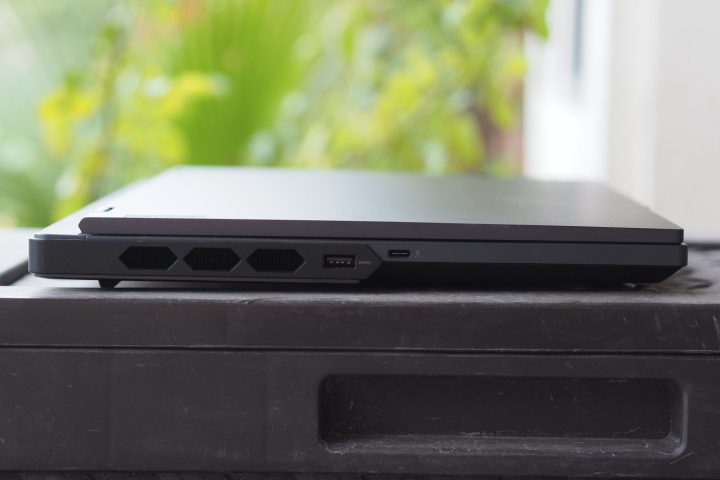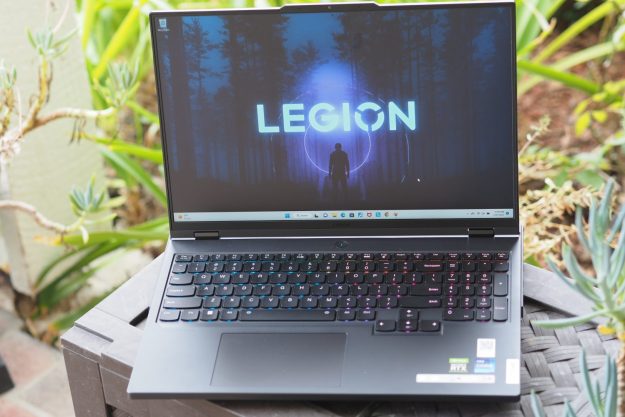
“It could pass for a workstation, but the Lenovo Legion Pro 7i packs a wallop for gamers and creatives alike.”
- Superior productivity and creative performance
- Excellent gaming performance
- Conservative aesthetic
- Great gaming display
- Good keyboard and touchpad
- Relatively affordable
- Thick and heavy
- Ray tracing performance is lacking
- Poor battery life
The Lenovo Legion Pro 7i is the company’s flagship gaming laptop, offering up the highest-end components and a design that’s tuned for gaming. The latest model sports a very fast Intel 13th-gen Raptor Lake CPU and a high-end Nvidia GPU, for a price that’s quite reasonable compared to much of the competition.
It’s a well-built, conservatively styled laptop that won’t appeal directly to gamers, but will have wider appeal among those who want to use its power for productivity and creative tasks. And the Legion Pro 7i has plenty of that — power — and is one of the fastest laptops we’ve yet tested. The competition is on its way, but for now, the Legion Pro 7i is near the top of the gaming laptop leaderboard.
Specs and configurations
| Lenovo Legion Pro 7i | |
| Dimensions | 14.3 inches x 10.32 inches x 0.86 – 1.01 inches |
| Weight | 6.17 pounds |
| Processor | Intel Core i9-13900HX |
| Graphics | Nvidia GeForce RTX 4080 |
| RAM | 32GB DDR5-6000MHz |
| Display | 16.0-inch 16:10 WQXGA (2,560 x 1,600) IPS, 240Hz |
| Storage | 1TB PCIe 4.0 SSD |
| Touch | No |
| Ports | 4 x USB-A 3.2 Gen 1 1 x USB-C 3.2 Gen 2 1 x USB-C with Thunderbolt 4 1 x HDMI 2.1 1 x Ethernet RJ45 1 x 3.5mm audio jack |
| Wireless | Wi-Fi 6E and Bluetooth 5.1 |
| Webcam | 1080p |
| Operating system | Windows 11 |
| Battery | 99.9 watt-hours |
| Price | $2,750 |
There’s just one configuration of the Legion Pro 7i, $2,750 for a Core i9-13900HX, 32GB of DDR5-6000MHz RAM, a 1TB PCIe 4.0 SSD, and a 16.0-inch IPS display running at 240Hz. That’s a very fair price for the components, and, as we’ll see, a relative bargain given the performance.
Man, this thing is fast
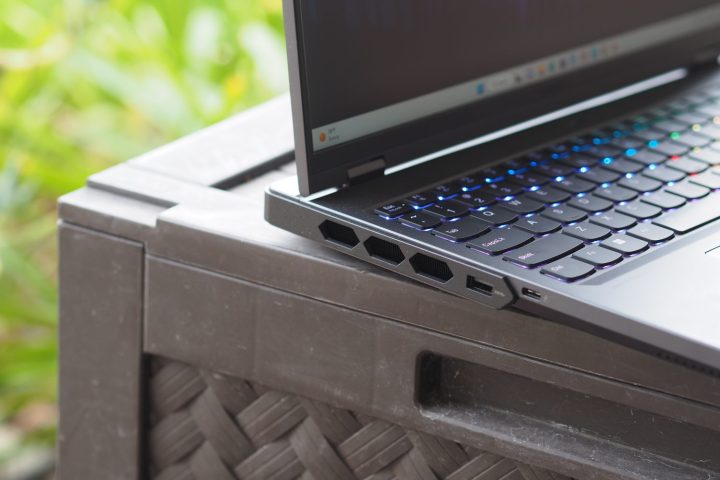
We’ll get to the Legion Pro 7i’s design later. I’m starting with performance because this is one incredibly fast laptop. That’s no surprise, given that it’s stocked with higher-end versions of the latest CPUs and GPUs available today.
First, there’s the Intel 13th-gen Raptor Lake Core i9-13900HX, a 24-core (eight Performance, 16 Efficient), 32-thread processor running at 55 watts and with a max Turbo Frequency of 5.4GHz. Then there’s the Nvidia GeForce RTX 4080 running at 175 watts, near the top end of Nvidia’s latest line of GPUs. The combination resulted in some of the fastest benchmark scores we’ve recorded on a laptop. I ran all tests in both normal and performance modes. There’s a GPU Overclock setting that I tested in the Pugetbench benchmark, but it made minimal difference.
In our standard CPU-intensive benchmarks, including Geekbench 5, Cinebench R23, and our Handbrake test that encodes a 420MB video as H.265, the Legion Pro 7i achieved the second-best scores among all the laptops we’ve tested. That includes Apple’s MacBook Pro 14 with the M2 Max. The only laptop that has matched it so far is the 2023 MSI GT77 Titan with a Core i9-13980HX and an RTX 4090. Keep in mind, though, that the MSI costs about $2,000 more than the Legion Pro 7i.
The Legion Pro 7i also scored the highest we’ve seen from any machine, laptop or desktop, in the PugetBench Premiere Pro benchmark that runs a live version of Adobe’s Premiere Pro 2022. It hit 1,436 in performance mode, where the next-highest score was 1,347 by a desktop PC running an Intel Core i9-12900KS with an RTX 3090. It was also much faster than the MacBook Pro 16 running the M1 Max (1,167) and the MacBook Pro 14 with the M2 Max (1,093). The 2023 MSI GT77 Titan was tested in a later version of the software, where it scored 1,031 versus the Lenovo’s 1,441 in the same version. That’s an impressive showing and should be exciting for demanding creators who need the best performance, particularly given the Legion’s lower price.
Right now, if you’re looking for one of the fastest productivity and creativity laptops you can buy without spending massive amounts of money on a portable workstation (that might not even be faster), then the Legion Pro 7i is the laptop for you. There will be others with the same components coming out that will likely be just as fast, like the latest MSI GT77 Titan, but for now, the Legion Pro 7i is right there at the top and even takes the lead in some benchmarks.
| Handbrake (seconds) |
Cinebench R23 (single/multi) |
PugetBench for Premiere Pro 2022 |
Geekbench (single/multi) |
|
| Lenovo Legion Pro 7i (i9-13900HX / RTX 4080) |
Bal: 55 Perf: 51 |
Bal: 2,096 / 22,596 Perf: 2,046 / 28,263 |
Bal: 1,151 Perf: 1,436 |
Bal: 2,020 / 19,041 Perf: 1,951 / 20,694 |
| MSI GT77 Titan 2023 (Core i9-13980HX / RTX 4090) | Bal: N/A Perf: 47 |
Bal: N/A Perf: 2,103 / 28,921 |
N/A | Bal: N/A Perf: 2,068 / 20,622 |
| MSI GT77 Titan (Core i9-12900HX / RTX 3080 Ti) | Bal: N/A Perf: 56 |
Bal: N/A Perf: 1,833 / 20,007 |
Bal: N/A Perf: 883 |
Bal: N/A Perf: 1,838 / 15,655 |
| Razer Blade 17 (Core i7-12800H / RTX 3080 Ti) | Bal: 73 Perf: N/A |
Bal: 1,697 / 13,218 Perf: N/A |
Bal: 969 Perf: N/A |
Bal: 1,808 / 11,843 Perf: N/A |
| MSI GE76 Raider (Core i9-12900HK / RTX 3080 Ti) | Bal: N/A Perf: 72 |
Bal: N/A Perf: 1,872 / 16,388 |
Bal: N/A Perf: 876 |
Bal: N/A Perf: 1,855 / 13,428 |
There’s a 99.9 watt-hour battery inside the Legion Pro 7i, but with its powerful components and large, high-resolution display, I didn’t expect much in the way of battery life. And indeed, the Legion was unimpressive. It managed just 3.25 hours in our web-browsing test, 6.75 hours in our video-looping test, and it wouldn’t complete the PCMark 10 Applications battery test. Clearly, the Legion Pro 7i isn’t designed to be a portable workstation, and that’s one area where the long-lasting MacBook Pro 16 is more compelling.
And yes, it can game too
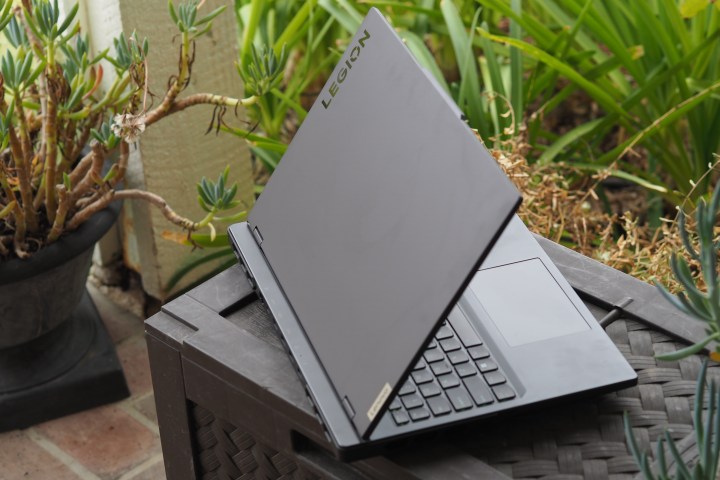
The Legion Pro 7i also pushed out some of the fastest 3DMark Time Spy scores we’ve seen in a laptop, especially in performance mode, where it was second to the 2023 MSI GT77 Titan. As with the Pugetbench benchmark, I tested with the GPU Overclock setting turned on, but it made little difference. So, I ran our gaming benchmarks in normal and performance modes. Note that the MSI laptops only have “performance” modes to go with “quiet” and “overclocked,” so I reported the performance mode results here. The Razer Blade 17 didn’t have selectable modes when we tested it.
While the Legion Pro 7i held its own against the MSI in our productivity and creativity benchmarks, it fell behind in our gaming tests. That’s to be expected, given the MSI’s faster GPU. The Legion Pro 7i outperformed the laptops running older tech, with performance mode making more or less of a difference depending on the title and the settings.
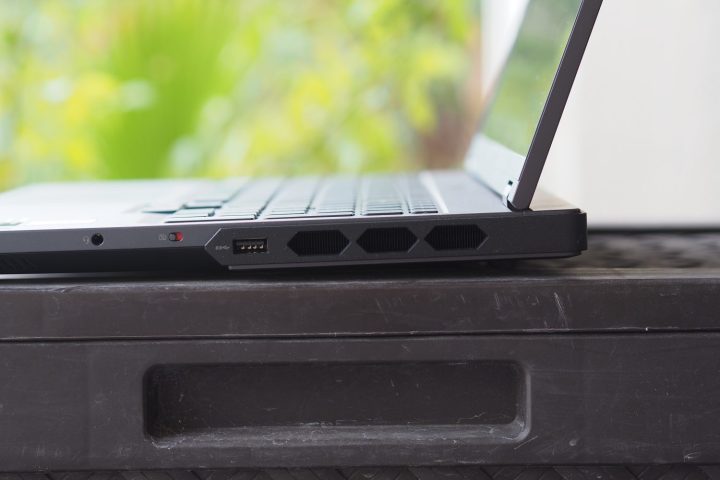
The following are benchmarks results at 1080p, which is what we typically report. The Legion Pro 7i performed well at 1440p in Cyberpunk 2077, dropping only a few frames per second (fps) and keeping it ahead of the older laptops. In Red Dead Redemption 2, it fell by around 20 fps in 1440p, but remained quite playable. The drop when switching to 1440p was roughly the same in Assassin’s Creed Valhalla, with about a 20 fps reduction in performance mode. Again, though, the Legion was faster than previous-generation machines.
One area where the Legion didn’t perform well was in Cyberpunk 2077 with ray tracing turned on. Here, it turned in frame rates that matched the RTX 3080 Ti-equipped laptops. Hopefully, that’s something that Lenovo and Nvidia can work to improve in the next set of drivers.
Overall, the Legion Pro 7i isn’t quite as dominating a gaming laptop as it is a creator’s machine, but it’s still quite fast and performs well in line with its price. You’re getting a gaming laptop fully capable of 1440p gaming with graphical details turned up, without having to sell a kidney to pay for it.
| Lenovo Legion Pro 7i (RTX 4080) |
MSI GT77 Titan 2023 (RTX 4090) |
MSI GT77 Titan (RTX 3080 Ti) |
Razer Blade 17 (RTX 3080 Ti) |
|
| 3DMark Time Spy | Bal: 18.017 Perf: 18,382 |
Bal: N/A Perf: 20,836 |
Bal: N/A Perf: 13,361 |
Bal: 12,6334 Perf: N/A |
| 3DMark Fire Strike | Bal: 33,162 Perf: 32,384 |
Bal: N/A Perf: 35,827 |
Bal: N/A Perf: 29,419 |
Bal: 26,661 Perf: N/A |
| Assassin’s Creed Valhalla (1080p Ultra High) |
Bal: 125 Perf: 129 fps |
Bal: N/A Perf: 150.9 fps |
Bal: N/A Perf: 87 fps |
Bal: 83 fps Perf: N/A |
| Red Dead Redemption 2 (1080p Ultra) |
Bal: 95 fps Perf: 120 fps |
Bal: N/A Perf: 137 fps |
Bal: N/A Perf: 95 fps |
Bal: 90 fps Perf: N/A |
| Cyberpunk 2077 (1080p Ultra) |
Bal: 114 fps Perf: 113 fps |
Bal: N/A Perf: 132.7 fps |
Bal: N/A Perf: 98 fps |
Bal: 91 fps Perf: N/A |
The design is pedestrian, but that’s OK

If you’re looking for an ostentatious gamer aesthetic, then you’ll be disappointed with the Legion Pro 7i. It’s a rather chunky laptop constructed of CNC-machined aluminum and it’s all-black. The only nod to gamers is per-key RGB keyboard lighting and an RGB “U” light strip across the front bottom of the chassis.
Otherwise, you’ll find simple lines and large, but functional venting. I have no problem with the aesthetic because if I need a powerful machine I can haul around and use in non-non-gamer environments, the Legion Pro 7i will fit right in. Its construction is top-notch, with no bending, flexing, or twisting. It ranks with the best-made gaming machines, such as the Razer Blade 17. Thanks to surprisingly small top and side bezels and a reverse notch housing the webcam, the chassis is reasonably sized for a 16-inch machine. It’s thick, though, and it’s over 6 pounds, making it a hefty laptop to take along with you. And then you’ll want to add in the huge 330-watt power brick.
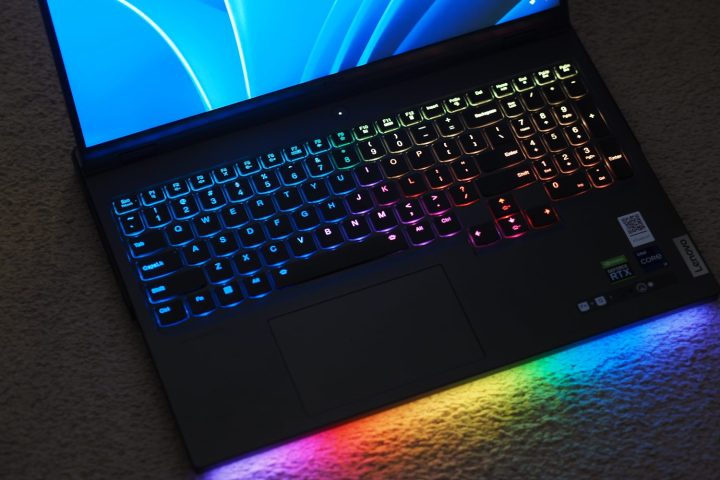
Lenovo put a great deal of thought into the laptop’s thermal design. ColdFront 5.0 technology offers dual fans and a vapor chamber system that sucks in air through the keyboard and the bottom vents, while hot air exits out the side and rear vents. That can make things toasty if your hand is too close to the side. The system also maximizes power to both the CPU and GPU, which was almost certainly a factor in the laptop’s excellent performance.
Lenovo used its Legion TrueStrike keyboard in the Legion Pro 7i, which offers sufficient travel and actuation to make mashing the keys during intense gaming comfortable enough. Then there’s 100% anti-ghosting and per-key RGB lighting that can be customized using a Lenovo utility. The keyboard feels good for gaming, but its switches are a little stiff, with an abrupt bottoming action that’s not as comfortable for long typing sessions. The touchpad is smaller than it should be given all the available space on the palm rest, but it’s precise, with quiet, confident button clicks. Unsurprisingly, the display isn’t touch-enabled.
Connectivity is great, with plenty of legacy and modern ports. Most are aligned along the back and so they don’t get in the way, including the proprietary power connector that uses the massive power brick mentioned earlier. Wi-Fi is up-to-date and performed well during our testing.
Finally, there’s a 1080p webcam, which is always welcome, and it offers a physical switch to shut it off electronically for enhanced privacy. There’s no biometric login, so you’re left with typing in a PIN or password to log into the machine.
A good display optimized for gaming
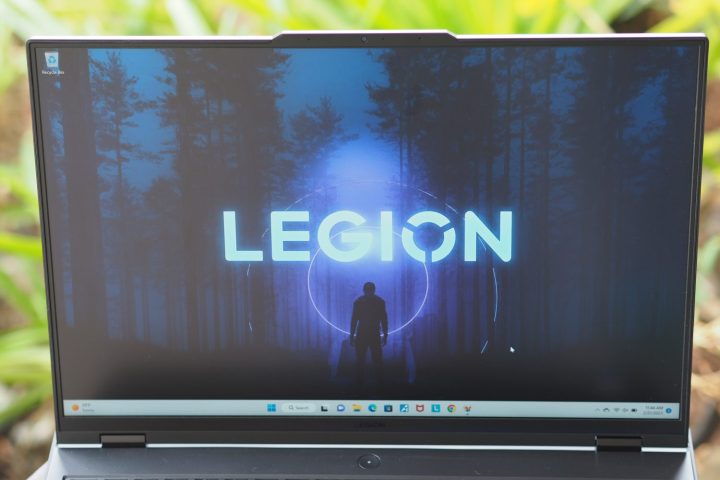
The Legion Pro 7i sports a 16.0-inch 16:10 IPS display running at WQXGA (2,560 x 1,600), with a fast refresh rate of 240Hz. Subjectively, it’s a fine display, with plenty of brightness, good contrast, and colors that are attractive and unsaturated.
According to my colorimeter, the display is optimized for gaming. It’s very bright at 529 nits, which helps if you want to run HDR-enabled games, and its contrast is deep enough at 1,140:1. Its colors aren’t terribly wide, though, close to the premium laptop average at 100% sRGB and 77% AdobeRGB, with great accuracy at DeltaE 0.62 (less than 1.0 is considered excellent).
While it can’t keep up with the mini-LED display in the 2023 MSI GT77 Titan or the OLED display in the latest Razer Blade 15, especially in its contrast, it’s great for productivity work and provides good enough performance for gamers. The laptop isn’t fast enough to fully use the 240Hz refresh rate in modern titles at 1440p with graphics turned up, but that still leaves it with plenty of headroom for older games and lower settings.
Two speakers on the front side edges of the chassis provide audio. They’re Harman speakers with Nahimic 3D Audio, but I didn’t test its surround sound capabilities. It put out sufficient volume to overcome the reasonable fan noise during gaming, with OK mids and highs and a lack of bass. You’ll probably want a good set of gaming headphones or external speakers for the best audio experience.
A better creator’s laptop, but still more than fast enough for gamers
I was more impressed with how the Legion Pro 7i tackled our productivity and creative benchmarks than I was with its gaming performance. It’s in second place behind the 2023 MSI GT77 Titan, which costs $2,000 more, so I’m not really complaining.
If you want a gaming laptop that performs well and that can be used in non-gaming environments without standing out, then the Legion Pro 7i is a great choice. The fact that it’s reasonably affordable, given the components inside, is just icing on the cake.
Editors' Recommendations
- No, The Last of Us PC requirements aren’t changing
- The most demanding PC games that push your rig to the limit
- Meta Quest Pro vs. Quest 2: a clear choice for VR gaming
- The best HP laptops
- A new iMac and 15-inch MacBook Air are almost ready to launch
